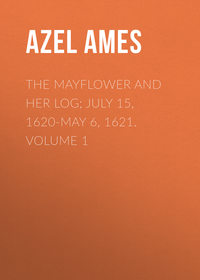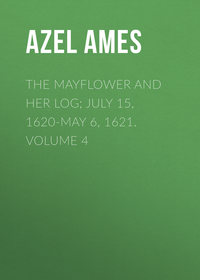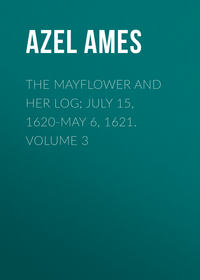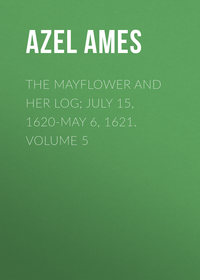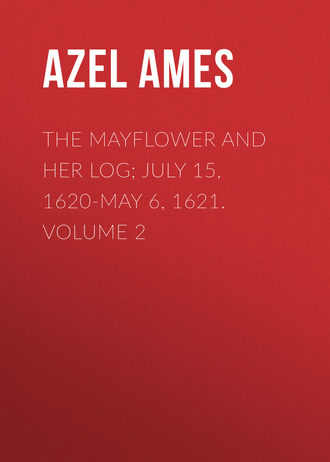 полная версия
полная версияThe Mayflower and Her Log; July 15, 1620-May 6, 1621. Volume 2
No complete list of the original "seventy" has ever been found, and we are indebted for the names of forty-two, of the fifty who are now known, to the final "Composition" made with the Pilgrim colonists, through the latter's representatives, November 15/25, 1626, as given by Bradford, and to private research for the rest. The list of original members of the company of Merchant Adventurers, as ascertained to date, is as follows. More extended mention of them appears in the notes appended to this list.
Robert Allden, Thomas Fletcher, Emanuel Altham, Thomas Goffe, Richard Andrews, Peter Gudburn, Thomas Andrews, William Greene, Lawrence Anthony, Timothy Hatherly, Edward Bass, Thomas Heath, John Beauchamp, William Hobson, Thomas Brewer, Robert Holland, Henry Browning, Thomas Hudson, William Collier, Robert Keayne, Thomas Coventry, Eliza Knight, John Knight, John Revell, Miles Knowles, Newman Rookes, John Ling, Samuel Sharpe, Christopher Martin(Treasurer pro tem.), James Shirley (Treasurer), Thomas Millsop, William Thomas, Thomas Mott, John Thornell William Mullens, Fria Newbald, Matthew Thornell William Pennington, William Penrin. Joseph Tilden, Edward Pickering, Thomas Ward, John Pierce, John White, John Pocock, John Wincob, Daniel Poynton, Thomas Weston, William Quarles, Richard Wright.
Shirley, in a letter to Governor Bradford, mentions a Mr. Fogge and a Mr. Coalson, in a way to indicate that they might have been, like himself, Collier, Thomas, Hatherly, Beauchamp, and Andrews, also of the original Merchant Adventurers, but no proof that they were such has yet been discovered. It has been suggested that Sir Edwin Sandys was one of the number, at the inception of the enterprise, but—though there is evidence to indicate that he stood the friend of the Pilgrims in many ways, possibly lending them money, etc.—there is no proof that he was ever one of the Adventurers. It is more probable that certain promoters of Higginson's and Winthrop's companies, some ten years later, were early financial sponsers of the MAY-FLOWER Pilgrims. Some of them were certainly so, and it is likely that others not known as such, in reality, were. Bradford suggests, in a connection to indicate the possibility of his having been an "Adventurer," the name of a "Mr. Denison," of whom nothing more is known. George Morton of London, merchant, and friend of the leaders from the inception, and later a colonist, is sometimes mentioned as probably of the list, but no evidence of the fact as yet appears. Sir George Farrer and his brother were among the first of the Adventurers, but withdrew themselves and their subscriptions very early, on account of some dissatisfaction.
It is impossible, in the space at command, to give more than briefest mention of each of these individual Adventurers.
Allden. Was at one time unfriendly to the Pilgrims,—Bradford calls him "one of our powerfullest opposers,"—but later their ally. Little is known of him. He appears to have been of London.
Altham. Was Master of the pinnace LITTLE JAMES, belonging chiefly to Fletcher, and apparently expected to command her on her voyage to New Plymouth in 1623, as consort of the ANNE, but for some reason did not go, and William Bridge went as her Master, in his stead.
Andrews (Richard). Was one of the wealthiest and most liberal of the Adventurers. He was a haberdasher of Cheapside, London, and an Alderman of the city. He became an early proprietor and liberal benefactor of the Massachusetts Bay Company, but most illogically gave the debt due him from Plymouth Colony (L540) to the stronger and richer Bay Colony. He had been, however, unjustly prejudiced against the Pilgrims, probably through the deceit of Pierce, Weston, Shirley, and Allerton.
Andrews (Thomas). A Lord Mayor of London, reputed a brother of the last- named. Never very active in the Adventurers' affairs, but friendly, so far as appears.
Anthony. Little or nothing is known concerning him.
Bass. Was one of the enduring friends of the struggling Colony and loaned them money when they were in dire straits and the prospect of recovery was not good. He was of London, and considerable is known concerning him.
Beauchamp. Was one of the most active of the Company for many years. Generally to be relied upon as the Colony's friend, but not without some sordid self seeking. Apparently a wealthy citizen and "salter" of London.
Brewer. Is too well-known as long the partner of Brewster in the conduct of the "hidden press" at Leyden, and as a sufferer for conscience' sake, to require identification. He was a wealthy man, a scholar, writer, printer, and publisher. Was of the University of Leyden, but removed to London after the departure of the chief of the Pilgrims. Was their stanch friend, a loyal defender of the faith, and spent most of his later life in prison, under persecution of the Bishops.
Browning. Does not appear to have been active, and little is known of him.
Collier. Was a stanch and steadfast friend. Finally cast in his lot with the Pilgrims at New Plymouth and be came a leading man in the government there. His life is well known. He was a "brewer."
Coventry. Appears only as a signer, and nothing is known of him.
Fletcher. Was a well-to-do merchant of London, a warm friend and a reliance of the Pilgrims. The loss of the LITTLE JAMES was a severe blow to him financially.
Greene. Appears to have been a merchant and a partner in Holland (and perhaps at London) of Edward Pickering. They were well acquainted personally with the Pilgrims, and should have been among their most liberal and surest friends. Facts indicate, however, that they were sordid in their interest and not entirely just.
Goffe. Was a London merchant and ship-owner, as else where appears. He was not only a Merchant Adventurer, but a patentee and deputy- governor of the Massachusetts Company, and an intimate friend of Winthrop. He lost heavily by his New England ventures. There is, as shown elsewhere, good reason to believe that he was the owner of the MAY-FLOWER on her historic voyage, as also when she came over in Higginson's and Winthrop's fleets, ten years later.
Gudburn. Appears only as a signer, so far as known.
Hatherly. Was a well-to-do friend of the Pilgrims, and after many complaints had been made against them among the "Purchasers"– arising out of the rascality of Shirley and Allerton—went to New England on a mission of inquiry. He was perfectly convinced of the Pilgrims' integrity and charmed with the country. He made another visit, and removed thither in 1633, to remain. He became at once prominent in the government of New Plimoth Colony.
Heath. Does not appear to have been active, and naught is known of him.
Hobson. Is known only as a signer of the "Composition."
Holland. Was a friend and ally of the Pilgrims, and one of their correspondents. He is supposed to have been of the ancient house of that name and to have lived in London.
Hudson. Was not active, and appears as a signer only.
Keayne. Was a well-to-do citizen of the vicinity of London, a friend, in a general way, of the Pilgrims. He came to Boston with Winthrop. Was prominent in the Massachusetts Colony. Was the founder and first commander of the early Artillery Company of Boston, the oldest military organization of the United States, and died at Boston, leaving a large estate and a very remarkable will, of which he made Governor Winslow an "overseer." He was an erratic,—but valuable, citizen.
Knight (Eliza). Seems to have been the only woman of the Adventurers, so far as they are known, but no thing is known of her. It has been suggested that the given name has been wrongly spelled and should be "Eleazar,"—a man's name,—but the "Composition" gives the signature as Eliza, clearly, as published.
Knight (John). Finds no especial mention. He was probably a relative of Eliza.
Knowles. Appears only as a signer of the "Composition."
Ling. Was a wealthy friend of the colonists and always true to them. He lost his property and was in poverty when the Pilgrims (though not yet well on their feet), in grateful remembrance of his fidelity, sent him a generous gift.
Martin. Was the first treasurer of the colonists and also a MAY-FLOWER Pilgrim. Mention of him appears later. He was no credit to the Company, and his early death probably prevented much vexation.
Millsop. Appears only as a signer of the "Composition."
Mott. Has no especial mention, but is believed to have sent some of his people to Plymouth Colony at an early day.
Mullens. Was, as appears elsewhere, a well-conditioned tradesman of Surrey, England, who was both an Adventurer and a MAY-FLOWER Pilgrim, and Martin and himself appear to have been the only ones who enjoyed that distinction. He died, however, soon after the arrival at Plymouth. That he was an Adventurer is but recently discovered by the author, but there appears no room for doubt as to the fact. His record was brief, but satisfactory, in its relation to the Pilgrims.
Newbald. Finds no especial mention.
Pennington. Appears only as a signer. It is a London name.
Penrin. Appears only as a signer of the "Composition."
Pickering. Is introduced to us first as a Leyden merchant, through John Robinson's letters. He appears to have been a shrewd, cold-blooded calculator, like his partner-Adventurer, Greene, not interested especially in the Pilgrims, except for gain, and soon deserting the Adventurers. His family seem to have been in favor with Charles II. (See Pepys' "Diary.")
Pierce (John). Although recognized by the Virginia Companies and Council for New England, as the representative of the Adventurers, he has only been recently generally reckoned a chief man of the Adventurers. A Protean friend of the Pilgrims, never reliable, ever pretentious, always self-seeking, and of no help. He was finally ruined by the disasters to his ship, the PARAGON, which cost him all his interests. Having attempted treacherously to secure to himself the Patent granted in the Colony's interest, he was compelled by the Council to surrender its advantages to the Adventurers and colonists.
Pocock. Was a stanch and firm supporter of the Pilgrims and their interests, at all times, and to the end. He was also a financial supporter and deputy-governor the Massachusetts Company, under Winthrop. A correspondent of Bradford. A good man.
Poyton. Finds no especial mention. He appears as a signer only.
Quarles. Appears only as a signer of the "Composition."
Revell. Was a very wealthy citizen, merchant, and ship owner of London, and a good man. He became also ardently interested in Winthrop's Company. Was an "assistant" and one of the five "undertakers" chosen to go to New England to reside. He went to New England on the JEWELL of Winthrop's fleet, and was part owner of the LADY ARBELLA. He evidently, however, did not like the life, and returned after a few weeks' stay.
Rookes. Appears only as a signer.
Sharpe. Was also a friend of both Pilgrim and Puritan. He came to New England in 1629, and settled first at Salem, in the Massachusetts Company. He died in 1658, having long been a ruling elder of the church there. He met with many enemies, but was a valuable man and an able one. He was Governor Cradock's New England agent.
Shirley. Requires little mention here. The perfidious friend of the Pilgrims,—perhaps originally true to them,—he sunk everything for hope of gain. He was treasurer of the Adventurers, one of their most active and intelligent men, but proved a rascal and a canting hypocrite. He was a "citizen and gold-smith" of London.
Thomas. Has nowhere been enumerated in any list of the Adventurers (though occasionally mentioned as such by recent writers), which is strange, as repeated letters of his to Bradford, and other data, show him to have been one of the best and truest of them all. He sold his interests before the "Composition" and became a colonist after 1630. He was the fifth of the Adventurers to come to New England to remain, and cast in his lot with the Pilgrims at New Plimoth—Martin, Mullens, Collier, and Hatherly preceding him. A wealthy and well-informed man, he became a power in the government. Probably Welsh by birth, he was a London merchant when the Adventurers were organized. His home at Marshfield, Massachusetts, has since become additionally famous as the home of Daniel Webster.
Thornell (John). Is sometimes confounded with another Adventurer, Matthew Thornhill, as his name is some times so spelled. There is reason to believe they were related. He was not a friend to the Pilgrims.
Thornhill (or Thornell), (Matthew). Little is known concerning him.
Tilden. Was of an old family in Kent, "a citizen and girdler of London," as his will declares, his brother (Nathaniel) later coming to New England and settling near Hatherly at Scituate. Nathaniel's son Joseph—named for his uncle—was made his executor and heir. The uncle was always a firm friend of the Pilgrims. Mr. Tilden's will is given by Waters ("Genealogical Gleanings," vol. i. p. 71), and is of much interest.
Ward. Appears only as a signer.
White. Probably the Rev. John White, a stanch friend of the Pilgrims, although not a "Separatist," and intimately connected with the upbuilding of New England. His record was a broad and noble one. Goodwin says: "Haven thinks White was that Dorchester clergyman reputed to be the author of the Planters' Plea." Probably, but not certainly, William White of the Pilgrims was also an Adventurer.
Wincob (?). Was a gentleman of the family of the Countess of Lincoln, and the one in whose name the first patent in behalf of the Adventurers and Pilgrims (which, however, was never used) was taken. It is only recently that evidences which, though not conclusive, are yet quite indicative, have caused his name to be added to the list, though there is still a measure of doubt whether it belongs there.
Weston. Requires little mention here. Once a friend of the Pilgrims and unmistakably the organizer of the Adventurers, he became a graceless ingrate and rascal. An instrument of good at first, he became a heartless and designing enemy of the Planters. He was a "citizen and merchant [ironmonger] of London." It is altogether probable that he was originally a tool of Sir Ferdinando Gorges and was led by him to influence the Leyden brethren to break off negotiations with the Dutch. He died poor, at Bristol, England.
Wright. Perhaps came to New Plimoth and married a daughter of the MAY- FLOWER Pilgrim, Francis Cooke. If so, he settled at Rehoboth and became its leading citizen. He may possibly have been the settler of that name in the Bay-Colony, and the weight of evidence rather favors the latter supposition.
Of the Adventurers, Collier, Hatherly, Keayne, Mullens, Revell, Pierce, Sharpe, Thomas, and Weston, probably Wright and White, possibly others, came to America for longer or shorter periods. Several of them were back and forth more than once. The records show that Andrews, Goffe, Pocock, Revell, Sharpe, and White were subsequently members of the Massachusetts (Winthrop's) Company.
Professor Arberl finds but six of the Pilgrim Merchant Adventurers who later were among the Adventurers with Winthrop's Company of Massachusetts Bay, viz.:—Thomas Andrews, John Pocock, Samuel Sharpe, Thomas Goffe, John Revell, John White.
He should have added at least, the names of Richard Andrews and Robert Keayne, and probably that of Richard Wright.
Of their number, Collier, Hatherly, Martin, Mullens, Thomas, and (possibly) Wright were Plymouth colonists Martin and Mullens, as noted, being MAY-FLOWER Pilgrims. Nathaniel Tilden, a brother of Joseph Tilden of the Adventurers, came, as previously mentioned, to the Colony from Kent, settling at Scituate. Joseph, being apparently unmarried, made his nephew, Joseph of Scituate, his residuary legatee, and his property mostly came over to the Colony.
Collier, Hatherly, and Thomas all located within a few miles of one another, were all wealthy and prominent men in the government of the Colony, were intimate friends,—the first and last especially,—and lent not a little dignity and character to this new dependency of King James the First. The remaining twenty or thereabouts whose names are not surely known—though a few of them are pretty safely conjectured, some being presumably of the Holland Pilgrims and their friends—were probably chiefly small contributors, whose rights were acquired from time to time by others of larger faith in the enterprise, or greater sympathy or means. Not all, however, who had ceased to hold their interests when the "Composition" was made with Allerton in behalf of the colonists, in 1626, were of these small holders. Weston was forced out by stress of circumstances; Thomas moved to New England; Pierce was ruined by his ventures by sea; Martin and Mullens died in 1621; Pickering and Greene got out early, from distrust as to profits; Wincob alone, of this class, was a small investor, if he was one at all.
By far the greater portion of the sums invested by the Adventurers in behalf of the Colony is represented by those whose names are known, those still unknown representing, doubtless, numbers rather than amounts. It is, however, interesting to note, that more than four sevenths of the original number, as given by Captain John Smith, continued to retain their interests till the "Composition" of 1626. It is to be hoped that it may yet be possible to increase considerably, if not to perfect, the list of these coadjutors of the Pilgrims—the Merchant Adventurers—the contracting "party of the second part," to the charter-party of the MAY- FLOWER.
Who the Owner of the MAY-FLOWER was, or who his representative, the "party of the first part," to the charter party of the Pilgrim ship, cannot be declared with absolute certainty, though naturally a matter of absorbing interest. There is, however, the strongest probability, as before intimated, that Thomas Goffe, Esq., one of the Merchant Adventurers, and always a stanch friend of the Pilgrims, was the owner of the historic vessel,—and as such has interwoven his name and hers with the histories of both the Pilgrim and Puritan hegiras from Old to New England. He was, as previously stated, a wealthy "merchant and ship owner of London," and not only an Adventurer with the Leyden Pilgrims, but—nearly ten years later—a patentee of the Massachusetts Company and one of its charter officers.
We are told in the journal of Governor Winthrop of that Company—then on board the LADY ARBELLA, the, "Admiral" or flagship of his fleet, riding at Cowes, ready to set sail for New England—that on "Easter Monday (March 29), 1630, the CHARLES, the MAY-FLOWER, the WILLIAM AND FRANCIS, the HOPEWELL, the WHALE, the SUCCESS, and the TRIAL," of his fleet, were "still at Hampton [Southampton] and are not ready." Of these seven ships it is certain that Mr. Goffe owned at least two, as Governor Winthrop—in writing, some days later, of the detention of his son Henry and his friend Mr. Pelham, who, going ashore, failed to return to the governor's ship before she sailed from Cowes, and so went to the fleet at Southampton for passage—says: "So we have left them behind and suppose they will come after in one of Mr. Goffe's ships." It is clear, therefore, that Mr. Goffe, who was an intimate friend and business associate of Governor Winthrop, as the latter's correspondence amply attests, and was a charter deputy-governor of the Massachusetts Company, and at this time "an assistant," was the owner of at least two (probably not more) of these seven belated ships of the governor's fleet, riding at Southampton. Bearing in mind that the MAY-FLOWER and the WHALE were two of those ships, it becomes of much importance to find that these two ships, evidently sailing in company (as if of one owner), arrived together in the harbor of Charlestown, New England, on Thursday, July 1, having on board one of them the governor's missing son, Henry Winthrop. If he came—as his father expected and as appears certain—"in one of Mr. Goffe's ships," then evidently, either the MAY-FLOWER or the WHALE, or both, belonged to Mr. Goffe. That both were Goffe's is rendered probable by the fact that Governor Winthrop—writing of the vessels as if associated and a single interest—states that "most of their cattle [on these ships] were dead, whereof a mare and horse of mine." This probability is increased, too, by the facts that the ships evidently kept close company across the Atlantic (as if under orders of a common owner, and as was the custom, for mutual defence and assistance, if occasion required), and that Winthrop who, as we above noted, had large dealings with Goffe, seems to have practically freighted both these ships for himself and friends, as his freight bills attest. They would hence, so far as possible, naturally keep together and would discharge their cargoes and have their accountings to a single consignee, taken as nearly together as practicable. Both these ships came to Charlestown,—as only one other did,—and both were freighted, as noted, by one party.
Sadly enough, the young man, Henry Winthrop, was drowned at Salem the very day after his arrival, and before that of either of the other vessels: the HOPEWELL, or WILLIAM AND FRANCIS (which arrived at Salem the 3d); or the TRIAL or CHARLES (which arrived—the first at Charlestown, of the last at Salem—the 5th); or the SUCCESS (which arrived the 6th); making it certain that he must have come in either the MAY-FLOWER or the WHALE. If, as appears, Goffe owned them both, then his ownership of the MAY-FLOWER in 1630 is assured, while all authorities agree without cavil that the MAY-FLOWER of Winthrop's fleet in that year (1630) and the MAY- FLOWER of the Pilgrims were the same. In the second "General Letter of Instructions" from the Massachusetts Company in England—dated London, May 28, 1629—to Governor Endicott and his Council, a duplicate of which is preserved in the First Book of the Suffolk Registry of Deeds at Boston, the historic vessel is described as "The MAY-FLOWER, of Yarmouth- —William Pierse, Master," and Higginson, in his "Journal of a Voyage to New England," says, "The fifth ship is called the MAY-FLOWER carrying passengers and provisions." Yarmouth was hence undoubtedly the place of register, and the hailing port of the MAY-FLOWER,—she was very likely built there,—and this would remain the same, except by legal change of register, wherever she was owned, or from what ever port she might sail. Weston and Cushman, according to Bradford, found and hired her at London, and her probable owner, Thomas Goffe, Esq., was a merchant of that city. Dr. Young remarks: "The MAYFLOWER Of Higginson's fleet is the renowned vessel that brought the Pilgrim Fathers to Plymouth in 1620." Hon. James Savage says "The MAYFLOWER had been a name of renown without forming part of this fleet [Winthrop's, 1630], because in her came the devoted planters of Plimouth [1620] and she had also brought in the year preceding [1629] some of Higginson's company to Salem." Goodwin' says: "In 1629 she [the Pilgrim MAY-FLOWER] came to Salem with a company of the Leyden people for Plymouth, and in 1630 was one of the large fleet that attended John Winthrop, discharging her passengers at Charlestown." Dr. Young remarks in a footnote: "Thirty-five of the Leyden congregation with their families came over to Plymouth via Salem, in the MAY-FLOWER and TALBOT."
In view of such positive statements as these, from such eminent authorities and others, and of the collateral facts as to the probable ownership of the MAY-FLOWER in 1630, and on her earlier voyages herein presented, the doubt expressed by the Rev. Mr. Blaxland in his "Mayflower Essays," whether the ship bearing her name was the same, on these three several voyages, certainly does not seem justified.
Captain William Pierce, who commanded the MAY-FLOWER in 1629, when she brought over part of the Leyden company, was the very early and intimate friend of the Pilgrims—having brought over the ANNE with Leyden passengers in 1623—and sailed exclusively in the employ of the Merchant Adventurers, or some of their number, for many years, which is of itself suggestive.
To accept, as beyond serious doubt, Mr. Goffe's ownership of the MAY- FLOWER, when she made her memorable voyage to New Plimoth, one need only to compare, and to interpret logically, the significant facts;—that he was a ship-owner of London and one of the body of Merchant Adventurers who set her forth on her Pilgrim voyage in 1620; and that he stood, as her evident owner, in similar relation to the Puritan company which chartered her for New England, similarly carrying colonists, self-exiled for religion's sake, in 1629 and again in 1630. This conviction is greatly strengthened by the fact that Mr. Goffe continued one of the Pilgrim Merchant Adventurers, until their interests were transferred to the colonists by the "Composition" of 1626, and three years later (1629) sent by the MAY-FLOWER, on her second New England voyage, although under a Puritan charter, another company from the Leyden congregation. The (cipher) letter of the "Governor and deputies of the New-England Company for a plantation in Massachusetts Bay" to Captain John Endicott, written at Gravesend, England, the 17th of April, 1629, says: "If you want any Swyne wee have agreed with those of Ne[w] Plimouth that they deliver you six Sowes with pigg for which they a[re] to bee allowed 9 lb. in accompt of what they the Plymouth people owe unto Mr. Goffe [our] deputie [Governor]." It appears from the foregoing that the Pilgrims at New Plymouth were in debt to Mr. Goffe in 1629, presumably for advances and passage money on account of the contingent of the Leyden congregation, brought over with Higginson's company to Salem, on the second trip of the MAY-FLOWER. Mr. Goffe's intimate connection with the Pilgrims was certainly unbroken from the organization of their Merchant Adventurers in 1619/20, through the entire period of ten years, to 1630. There is every reason to believe, and none to doubt, that his ownership of the MAY- FLOWER of imperishable renown remained equally unbroken throughout these years, and that his signature as her owner was appended to her Pilgrim charter-party in 1620. Whoever the signatories of her charter-party may have been, there can be no doubt that the good ship MAY-FLOWER, in charge of her competent, if treacherous, Master, Captain Thomas Jones, and her first "pilot," John Clarke, lay in the Thames near London through the latter part of June and the early part of July, in the summer of 1620, undergoing a thorough overhauling, under contract as a colonist- transport, for a voyage to the far-off shores of "the northern parts of Virginia."




